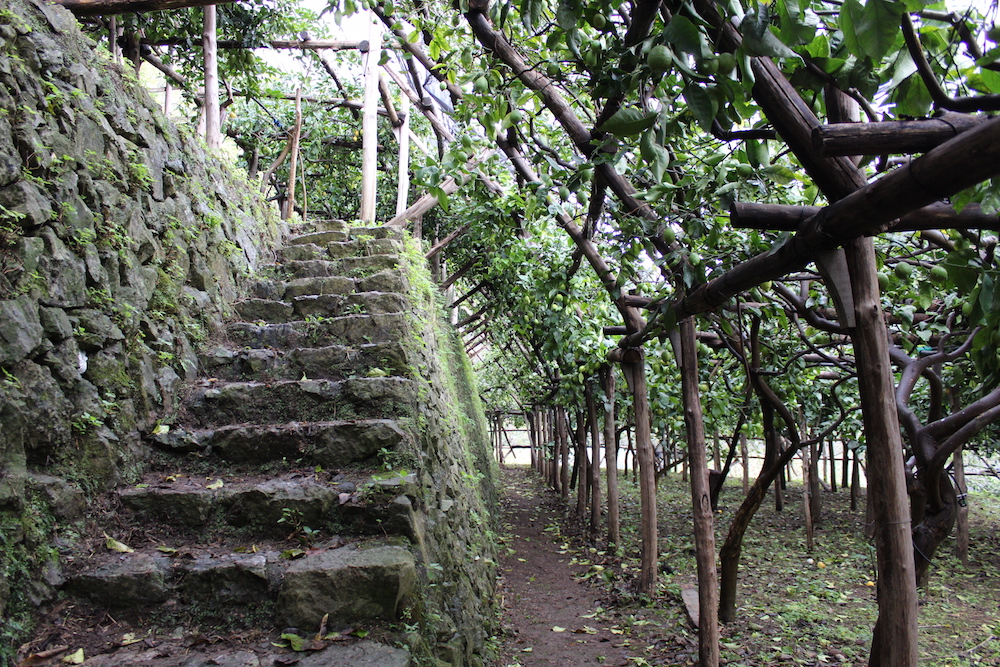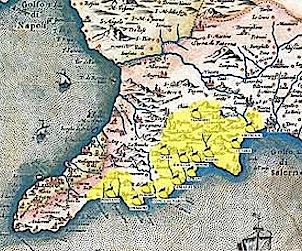
The lemon groves on Campania’s famous Amalfi Coast grow on ancient stone terraces.
The lemon groves of the Amalfi Coast cling precariously on terrazzi to the narrow creviced valleys that run up from the Mediterranean. Overlooking a collection of buildings, clustered around a slim point of a mountain stream where the Romans built a bridge 2,500 years ago, a group of Canadian food writers found itself enveloped under a living trellis of lemon trees. It’s magical under the rickety wooden grids and lemon tree branches that hold young green fruit. Some of the trees are 100 years old, and they’re all tied to the pergola, like vines, to encourage fruiting instead of vertical.
The lemons of the Amalfi Coast are called sfuzato, or spindles because of their elliptical shape. They’re prized enough to be protected and also go by their legal name, Limone Costa d’Almalfi I.G.P. What they’re being protected from are cheaper lemons from elsewhere in Europe and beyond, where the groves are flat, well spaced and able to be harvested with machines. Lemon farming on the Amalfi Coast hasn’t changed much since Roman times, and the lemons growing over our heads will have to be picked by hand, then carried down the terraced hills in baskets the harvesters carry on their heads. They’re prized for their flavour and fragrant oil.
Our group descends from the hills, collects in our bus and visits the Costeria Agrumi de Riso in the seaside village of Minori. Here lemons grown by the local cooperative are sorted and boxed for distribution and sale. Less pretty ones are reserved for the peels, which will make Amalfi’s famous liquor Limoncello. The peeled lemons will be sold cheaply to make icecream or lemon juice. We are entreated to a demonstration of how to make Limoncello. (The short version is you soak lemon peels in alcohol, strain after a few days and add sugar.)
After the demonstration we taste limoncello, which onomatopoetically tastes like lemon jello. With our refreshments, we offered a novel salad of lemon slices. Our mouths water and pucker at the thought of eating a raw lemon slice, however pretty they look. But the limoncello is sweet and might counter it, and we’ve traveled far to taste new things, so we try them. They’re not particularly sour at all. Our hosts have dressed the lemons in olive oil and a dash of white wine vinegar. The stronger acid of the vinegar has the curious effect of rendering the lemons sweet and the slices reveal a deep fragrant citrus flavour that we love. We finish the first plate, and then a second. Soon it’s time for a lemon themed lunch in the next town of Maiori, so we get back on the bus and leave with a new dinner party trick.
 Malcolm Jolley is a founding editor of Good Food Revolution and Executive Director of Good Food Media, the company that publishes it. Follow him on Twitter or Facebook.
Malcolm Jolley is a founding editor of Good Food Revolution and Executive Director of Good Food Media, the company that publishes it. Follow him on Twitter or Facebook.








do you have the lemon salad recipe
Yes: it’s in there Elizabeth David-style: add some olive oil and a dash of white wine vinegar to lemon slices. It’s that easy. They cut the slices into quarters and served with a toothpick sticking out to grip with.